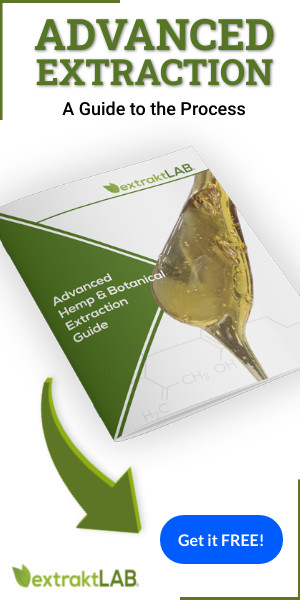Supercritical CO2 Extraction
There are many methods to accomplish hemp extraction – many of which are effective in their own way. However, the CO2 extraction process is often the preferred method for those producers looking to create a clean, potent product while keeping long-term operational costs low using extraktLAB’s Supercritical CO2 Extractor machine. Read on to discover why supercritical CO2 extraction is one of the optimal choices for manufacturers and consumers alike in the hemp extraction industry.
Topics and Information Guide
- What is Supercritical CO2 Extraction?
- What is the Labor Difference Between Ethanol Extraction vs. Supercritical CO2 Extraction?
- CO2 Extraction Process and Equipment
- Benefits and Advantages of CO2 Extraction
- Why CO2 is the Superior Extraction Process
- Three Common Extraction Processes
- CO2 Extract Products in the Hemp Industry
- Why extraktLAB Chooses Supercritical CO2
- Frequently Asked Questions
- Contact Us
What is Extraction?
Extraction is a separation technique seeking to separate a target compound from its matrix. This is not the same as chromatography, filtration or distillation. The goal is to selectively remove the compounds desired from resin. This is done in a number of methods that are performed to create distillate and isolate extracts from botanical biomass.
What is an Extraction Method?
Extraction methods are the different ways to separate target compounds from a fluid – such as separations of gases, liquids, liquid from solids, gas from liquid, and acids from base. Extraction methods always incorporate your method, accessories, and consumable.
What is Supercritical CO2 Extraction?
Supercritical CO2 extraction is used in a wide array of extraction systems from essential oils to decaffeinated coffee. The most famous and successful industrial process for supercritical CO2 extraction is the coffee decaffeination process. It can also be used to extract any botanical oil from any plant material.
There are many other essential oil extracts that are used in the supplements industry that utilize this process. Hops is a good example. Hops are used to brew beer and add flavor to beer. This method is used to extract the essential bitter flavor from the house so that the flavors can be blended and preserved. For hemp extraction, CO2 is used to extract CBD oil from hemp biomass.
To put it simply, CO2 extraction uses pressurized carbon dioxide in select temperatures to pull desired cannabinoids from hemp biomass. With the combination of special temperatures and pressures, CO2 reaches what is called a supercritical state. This is a crucial factor in the CBD extraction process that allows for a complete extraction at an efficient throughput.
What is the Labor Difference between Ethanol Extraction vs. Supercritical CO2 Extraction?
The direct labor between the two techniques is essentially the same. However different configurations of equipment and different workflows can improve labor content and headcount.
The concept of value-added Labor in this instance is very important. Value added labor is the labor content that is spent by the laborer on direct conversion of the product into something the customer values. In reality most operations have a very low value-added labor in a very high overhead component to direct labor. We suggest the use of lean techniques and Value Stream mapping to improve workflow, reduce inventory, and by extension reduce the headcount required to produce a unit.
You may be asking what supercritical means and why it matters when it comes to creating CBD extraction systems. Let’s take a look at the process from start to finish inside a supercritical CO2 extractor to find out how this extraction process works.
CO2 Extraction Process and Equipment
You may be asking what supercritical CO2 extraction means and why it matters when it comes to creating CBD extracts. Let’s take a look at the process from start to finish inside a supercritical CO2 extractor to find out how this extraction process works.
Here’s how it works step by step:
To get an idea of how CBD extraction systems work, let’s run through three quick steps that explain how CO2 is used in supercritical conditions as an extraction solvent.
- The Supercritical CO2 extractors uses carbon dioxide (CO2) at an elevated temperature and pressure to extract soluble compounds from natural products. Carbon dioxide above the critical temperature (31ºC) and pressure (1071 psi) becomes a supercritical fluid, which has an increased capacity for solubilizing non-polar compounds.
- Under supercritical conditions, the CO2 behaves much like fluid solvents similar to hexane in terms of its solubility selectivity. This higher solubility means a highly efficient extraction of desirable cannabinoids. Raising the temperature and pressure of the liquid CO2 even further provides highly efficient extractions of oils in a shorter period of time.
- As it passes through the biomass, the supercritical fluid breaks down the non-polar compounds and dissolves them into the fluid. After the separation of desired cannabinoids, the fluid CO2 is reverted back to a gaseous state leaving a “crude oil” containing CBD, terpenes and residual plant materials ready for distillation and product formulation.
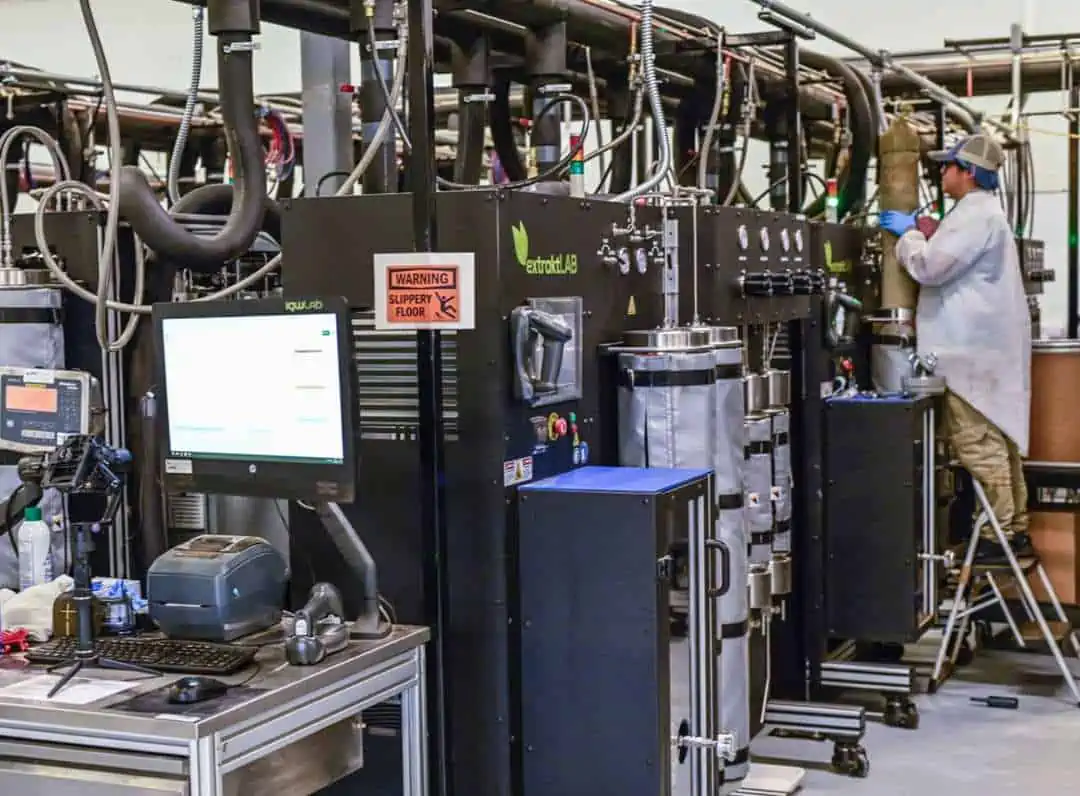
Subcritical and Supercritical CO2 Extraction Systems
The CO2 method can be performed at either supercritical or subcritical temperatures. This allows for beneficial variables based on a liquid viscosity – whether a specific CO2 extraction method requires more or less heat to speed the process of extraction without harming the purity of the end product. A subcritical CO2 extraction method produces a pure, solventless extract.
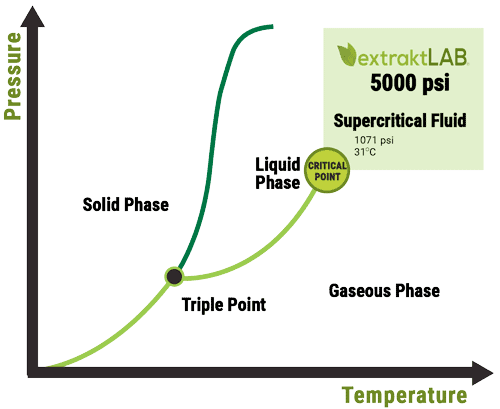
Want more detailed information? Take a look at the diagram below to see each step in the supercritical CO2 extraction process
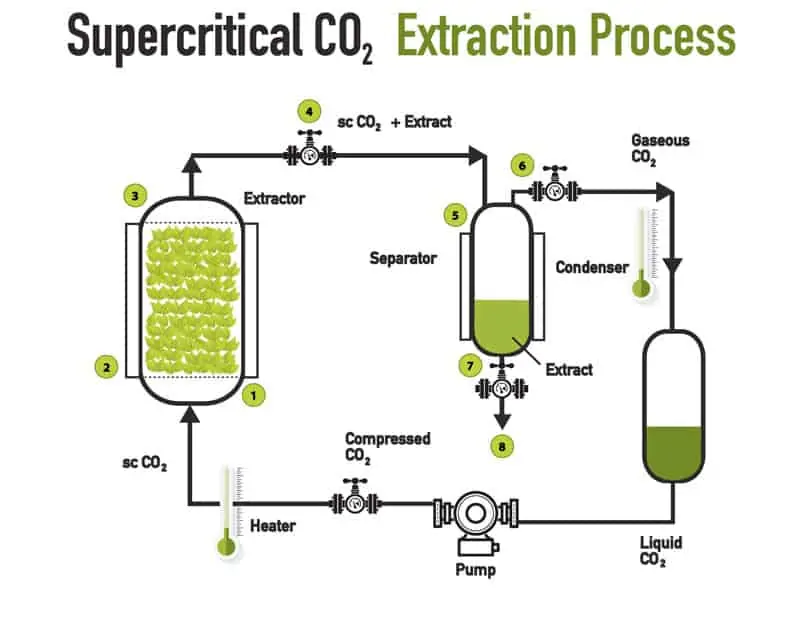
- Extractor chamber filled with ground cannabis/hemp (trim).
- Pump forces pressurized carbon dioxide at the optimum temperature, and in the liquid supercritical state (ScCo2), into the extractor chamber.
- The Supercritical carbon dioxide acts as a solvent with the cannabis, dissolving the cannabinoid compunds it contains
- The ScCO2 carries the cannabis oil particles past a pressure release valve into a separtor.
- In the separator the pressure is lower and the carbon dioxide reverts back into a gas, and separates from the cannabis oil.
- The carbon dioxide gas rises out of the oil and is routeed back to the CO2 tank to be used again in a closed loop system.
- The cannabis oil waxes and resin descend in the separator where they are captured in a collection vessel.
- The resulting substance is processed further into various products such as pure CBD-rich cannabis oil free of any solvents.
Benefits and Advantages of CO2 Extraction
So, we’ve seen how supercritical CO2 extraction systems work, and why it is so effective in the CBD extraction process, now let’s get into why CO2 is the preferred extraction process by many in the industry:
Clean and Green
CO2 extraction systems are by far the cleanest for consumer, producer and environment alike. Because CO2 is considered a natural solvent, a producer can more readily become a certified organic manufacturer. It also leaves out the potential risk for chemical residuals and contamination that are of concern with ethanol extraction. This natural solvent also eliminates any unwanted emissions into the environment making the “clean and green” solvent in extraction systems.
Cost
CO2 extraction is much less expensive to produce a kilogram of oil compared to ethanol extraction systems. For example, CO2 is 4 cents a pound compared to ethanol which is greater than $4 per pound. Solvent losses with ethanol extraction systems are a key cost contributor and drive a major increase in operating cost compared to CO2 extraction systems. As an example, 1-ton-per-day ethanol extraction systems would see an estimated $1,260,000 in solvent costs in just one year compared to just $42,048 using CO2.
Safest Products for Consumers
Because there are no chemical denaturants or volatile solvents left over in a ScCO2 product, it is undoubtedly the safest extraction process to create a safe product for consumers. A natural and organic solvent means customer assurance without sacrificing product potency making CO2 extraction systems the best choice for product formulation.
Calculate Your Extraction Business Operating Cost
Starting an Extraction Business? Check out our Calculators and to analyse costs, estimated revenue, yield, initial investments and important metrics for your extraction business.
Why CO2 is the Superior Extraction Process
We’ve said it before, and we’ll say it again: supercritical CO2 is a superior extraction process. But, now we’ll take a moment to quickly discuss the other common systems by which hemp are extracted.
Three Common Extraction Processes
Check these top 3 common extraction processes and see which one is suitable for your hemp and CBD extraction business. Learn the advantages and benefits of the different processes and determine the better extraction method for you.
Hydrocarbon Extraction
Extraction accomplished through hydrocarbon solvents is effective, but not entirely safe for producers or consumers. During extraction, it is vital to remember that common solvents in this category are hexane, propane and butane – all of which are very volatile. This poses an increased risk for fire and explosions. With that comes increased costs for blast-ready rooms, infrared gas detectors and C1D1 specifications that add to overall operational costs.
While the majority of these hydrocarbons are taken out of an extract during solvent removal, it is not guaranteed that the entirety of these byproducts will be removed. This means that consumers are faced with the choice of consuming a hemp extract containing parts-per-million (PPM) of these solvents. There is little research to assume that continued, daily use of these products will have no long-term health effects over the course of a consumer’s life.
Ethanol Extraction
Another popular extraction solvent, ethanol is a very effective method for extracting cannabinoids from hemp. The problem, however, comes in the most common form used for extraction: denatured ethanol. Where food grade ethanol is a very safe option (think grain alcohol as an example) it is far too costly for any sustainable business model. Therefore, manufacturers turn to denatured ethanol which is Generally Regarded As Safe (GRAS) by the FDA, but contains chemical denaturants used to deter recreational consumption so that it can be sold as fuel, cleaners and other products without paying beverage taxes.
Although denatured ethanol is created specifically with the intent of preventing human consumption, it is the common form of ethanol used in hemp extraction. Like hydrocarbon extraction, solvent removal eliminates a significant amount of the ethanol left over from the extraction process, but it is never guaranteed that all of the ethanol is removed. In fact, the FDA allows for certain PPM of pentane, methanol, hexane and other denaturants in extracts that are still considered “safe” for consumption. It is unknown whether or not daily consumption of residuals could have lasting negative effects on the body.
Supercritical CO2 Extraction
Incredibly efficient in its supercritical state, CO2 is a fast, clean, low-cost extraction that is tried and true. For producers, CO2 can be used for drastically lower costs than ethanol or hydrocarbon extraction simultaneously eliminating costs for blast ready facilities due to lack of flammability. Because it is natural, it also allows for obtaining organic certification and reduces harmful emissions that are harmful to the environment.
In summary, CO2 extraction, ethanol extraction and hydrocarbon extraction can produce desirable CBD extracts; however, CO2 extraction has an edge over ethanol and hydrocarbon extraction due to clean, high throughput efficiency and the avoidance of risk related to chemical contaminants. CO2 extraction is also much less expensive than other extraction solvents. For those reasons CO2 is a better extraction process.
CO2 Extract Products in the Hemp Industry
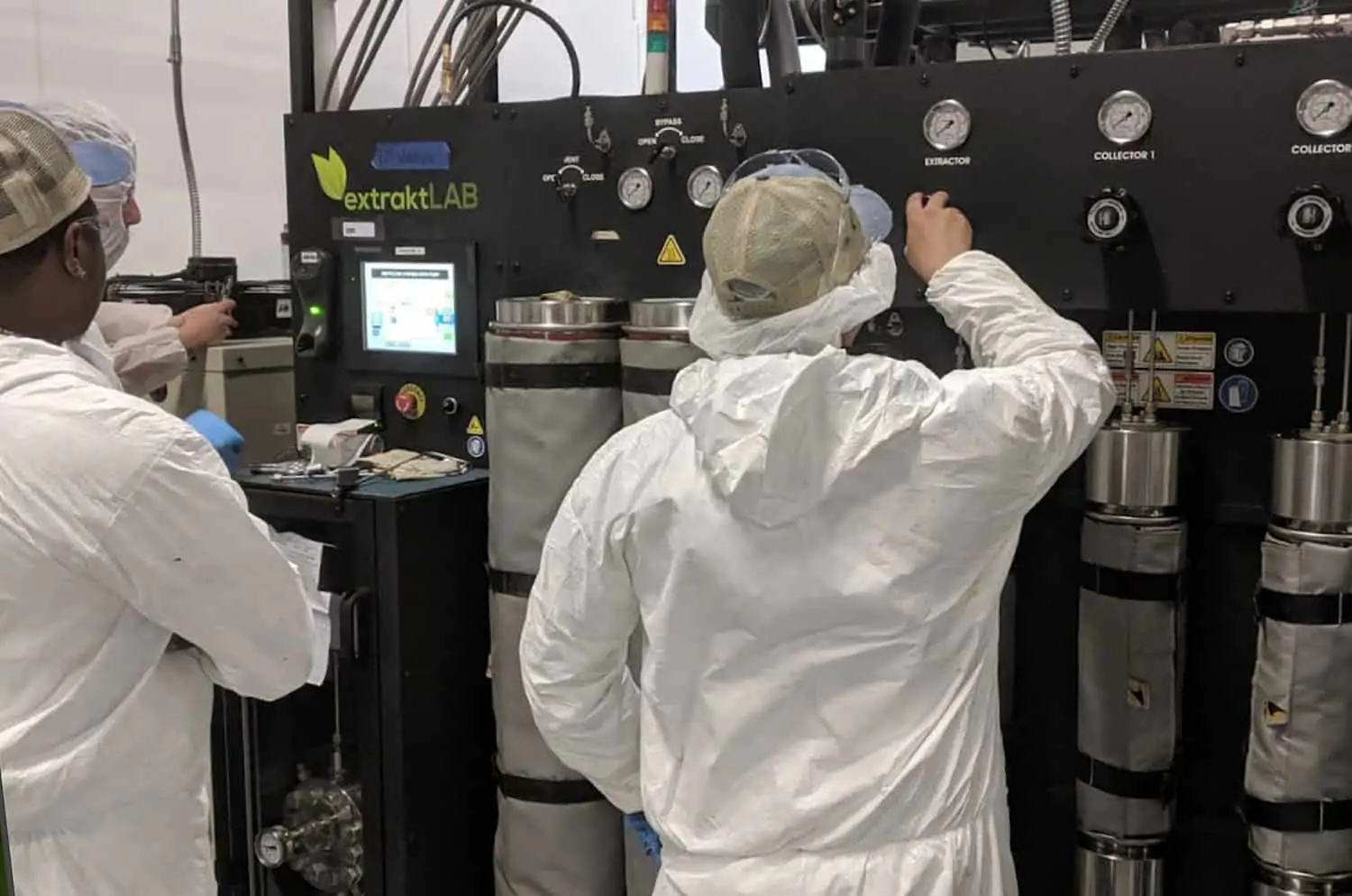
CO2 Supercritical extraction has become the preferred method for extracting CBD oils to serve markets with the most demanding standards for safety, quality, purity and consistency. It is also preferred by consumers for the same reasons, and progressive brands are proudly stating “ScCO2 extraction” on package labels. If a manufacturer uses the cleanest, safest extraction method to create their products, you can safely assume they will gladly display it on their packaging. This is a great way to verify a safe CBD product.
Because CO2 is a natural extraction solvent, it is a reliable CBD extraction process to create certified organic products. When it comes to consumable products, it’s safe to say that organic certification builds trust among customers making “clean and green” ScCO2 products a likely choice for health conscious hemp connoisseurs.
Anything made with CBD distillate or isolate means it was extracted. This includes tinctures, vape products, lotions, beauty products, edibles, and other varieties of hemp products. As mentioned above the safe and healthy choice is to seek out products that are extracted using supercritical CO2 which will be clearly labeled and mentioned on websites or packaging labels.
Supercritical Extraction Machine
We have the perfect machine for small, medium and large producers. Our model line makes it easy for you to scale your operations while keeping your operating costs at a minimum.
Why extraktLAB Chooses Supercritical CO2
The phrase “tried and true” is a perfect example of supercritical CO2 extraction. As new extraction trends emerge, their efficiency and safety come into question as seen with denatured ethanol and hydrocarbon extraction methods. At extraktLAB, we pride ourselves in using this clean and green extraction process and engineer equipment optimized to help other manufacturers do the same and to keep consumers safe and healthy.
Whether you are a farmer, grower, producer (extraction) or consumer interested in learning more about supercritical CO2, extraktLAB is here for you. Give us a call at 651-464-2822 to get your questions answered.
Frequently Asked Questions
Why should I choose extraktLAB equipment?
extraktLAB’s supercritical CO2 extractors are highly efficient and increase overall extraction yield. They are also capable of decreasing your yearly operating costs and leave scale up opportunities.
Does hemp biomass need to cure before extraction?
No, the material does not need to cure. Our methods complete the final drying step in a vacuum oven to bring the water content down from 10% to the 1% – 1.5% range for efficient CO2 extraction.
Can the drying process be accelerated using higher temps/lower humidity?
There are several drying methods used by growers to accelerate drying, but this is outside our scope of solutions. We recommend researching the agricultural methods to find what works best for you.
What are the typical conditions to dry hemp for extraction?
Harvest drying methods are outside the scope of our solutions; however, you want to dry the biomass to roughly 10% water content for quality storage to prevent mold or mildew.
When producing CBD from hemp, which part of the plant is typically used?
Typically flowers and leaves – no stems or stalks. Some producers will sort out the flowers and process them separately, but most processing includes the leaves and flowers.
Can ethanol become contaminated during ethanol extraction?
Yes, ethanol can become contaminated during ethanol extraction. It is important that you address the contamination with testing and reuse protocols. guidance for solvent reviews have been published by the FDA in 2010. Please refer to the many articles in this blog for more information on cross-contamination with extraction.
What is the solvent loss for ethanol extraction?
Hemp and cannabis biomass is an extremely absorbent material. As a consequence, a large amount of solvent volume must be added to the biomass to first solvate the biomass and then fluidize it. For ethanol extraction, approximately one gallon of ethanol is required to extract 1 lb of hemp. Solvent loss comes from the incomplete recovery of that solvent from the hemp.
The following table details the estimated solvent loss from ethanol extraction as a function of volume of hemp processed:
| Lbs processed per day | Daily requirement of
ethanol (gallons) |
Daily Loss of ethanol (gallons) at 90% recovery of ethanol | Max Cost of Solvent Loss per day:
$16-30/gal food grade ethanol $6-8/ gal denatured Calculated at $30/gal |
| 500 | 500-1500 | 50-150 | $1,500-45,000 |
| 1000 | 1000-3000 | 100-300 | $3,000-9,000 |
| 2000 | 2000-6000 | 200-600 | $6000-18,000 |
| 10000 | 10000-30000 | 1000-3000 | $30,000-90,000 |
Another source of solvent loss is incomplete recovery of solvent from the CBD hemp oil.
What is the electrical cost of ethanol extraction vs. CO2 extraction?
Processing a ton of hemp per day into extracts can be an energy-intensive process depending on how the hemp is extracted. The following table compares the energy expense for ethanol extraction versus the energy expense for CO2 extraction:
| Energy cost for Ethanol Extraction for 1 ton per day at 1 gallon ethanol per 1 lb of hemp | |
| 18711 | litres to cool from 25 to -20 |
| 16840 | litres to heat and evaporate after ethanol loss |
| 454 | kwhr to Cool from 25 to -20 |
| 481 | kwhr to heat to boiling point |
| 3105 | kwhr to evaporate |
| 4040 | kwhr total @ 100% Efficiency |
| 75% | Efficiency |
| 5387 | kwhr Total |
| $ 0.09 | per kwhr |
| $ 506.36 | per day |
| Energy cost for CO2 Extraction at 1 ton per day including winterization | |
| 636 | litres to cool from 25 to -20 |
| 636 | litres to heat and evaporate after ethanol loss |
| 15 | kwhr to Cool from 25 to -20 |
| 18 | kwhr to heat to boiling point |
| 117 | kwhr to evaporate |
| 151 | kwhr total @ 100% Efficiency |
| 75% | Efficiency |
| 201 | kwhr Total |
| $ 0.09 | per kwhr |
| $ 18.92 | per day for winterization |
| 43.20 | Kwhr per day for CO2 extractors |
| $ 3.88 | Per day for CO2 extractors |
How many times can I recycle or reuse ethanol from an ethanol extractor?
In guidance published by the FDA in 2010, plans for the reuse of solvents must be accompanied by a Declaration of the maximum number of times the solvent can be reused.
the FDA has recognized that contaminants buildup in the solvent over time as they are recovered and reused
As a consequence, the FDA guidelines recommend that the solvents be brought back to a suitable state before Reuse. A suitable reuse is defined by the original specifications for the solvent that is being used.
In keeping with a risk-based approach to process validation, the key risk to address with solvent reuse is cross-contamination. Cross-contamination could happen when a solvent dissolves a low level contaminant from the biomass being extracted. As the solvent is removed, the contaminant can become magnified and concentrated in either the oil or the solvent during solvent recovery. Cross contamination then occurs when a contaminated solvent is used to extract a non contaminated batch.
Contaminants are typically identified during incoming inspection but may show up later during processing as the oil becomes more refined. Hemp is typically sampled at receiving by quality assurance and a series of tests are conducted on the Hemp biomass in order to determine if the incoming material is contaminated with pesticides, solvents, heavy metals or if it has significant microbial content. Contaminants that are identified in the quality inspection should be tested for build up in the extraction solvent during validation.
Other sources for contamination include carbon black or activated carbon that is typically used in ethanol extraction to remove chlorophyll from the ethanol. Combustion byproducts that are incorporated into the structure of carbon black can dissolve in the ethanol and contaminate.
According to FDA guidelines, the number of times ethanol solvent can be reused must be validated according to a validation protocol. Once the method and process has been validated, the requirements for testing each reuse batch may not be required depending on the risks identified during the validation study.
As a general rule of thumb, a solvent may be reused successfully 20-50 times. Whatever your company’s current practice is, it is important to define the process, validate the process, establish specifications for reuse, and also set up a testing program to measure for contaminants. In all likelihood, a solvent changeover is probably in your future and it’s cost should not be neglected in your overall operating cost model. It is easy to estimate the cost of solving change over as it is the same as the start-up cost:
| Lbs processed per day | Daily requirement of
ethanol (gallons) |
Cost per gallon:
$16-30/gal food grade $6-8/ gal denatured Calculated at $30/gal |
| 500 | 500-1500 | $15,000-45,000 |
| 1000 | 1000-3000 | $30,000-90,000 |
| 2000 | 2000-6000 | $60,000-180,000 |
| 10000 | 10000-30000 | $300,000-900,000 |
The solvent changeover cost on a 60 day change over cycle can then be estimated on a per year basis according to the following table:
| Lbs processed per day | Change Over Frequency | Cost of Changeover | Max Annual Cost |
| 500 | 60 days | $15,000-45,000 | $270,000 |
| 1000 | 60 days | $30,000-90,000 | $540,000 |
| 2000 | 60 days | $60,000-180,000 | $1,080,000 |
| 10000 | 60 days | $300,000-900,000 | $5,400,000 |
By extension, the solvent testing costs will also be important to address:
| Lbs processed per day | Change Over Frequency | Cost of Testing
(pesticides, solvents), Unknowns testing can be 5-10k USD per unknown. |
Max Annual Cost |
| 500 | 60 days | $200-400 | $2400 |
| 1000 | 60 days | $200-400 | $2400 |
| 2000 | 60 days | $200-400 | $2400 |
| 10000 | 60 days | $200-400 | $2400 |
It is important to insist that unknowns be flagged by your laboratory.
What is supercritical CO2 extraction?
Supercritical CO2 extraction is used in hemp processing in hemp extraction for extracting CBD oil from hemp biomass. You can also be used to extract any Botanical oil from any plant material.
The co2 extraction typically takes place above the supercritical pressure and temperature for CO2. Is 1,070 PSI and 31 degrees Celsius.
Under supercritical conditions, the CO2 behaves much like hexane in terms of its solubility selectivity.
Would you recommend ethanol extracted oils for Vape products?
Due to the risk of chemical contaminants that are found in 25 to 30% of ethanol extracted oils, we recommend that CO2 oils be used for Vapor Products.
Is it possible to make a solventless extract with CO2?
It is absolutely possible to make a solventless extract with CO2. Solventless extracts are typically made with subcritical CO2 extraction methods.
Does ethanol extraction have a greater throughput than CO2 extraction?
Hemp processing equipment can be scaled for 1 to 5 tons of extracted hemp per day. It’s generally not a fair comparison to compare the throughput on an instrument from two different companies. What is fair is to specify the throughput At the tonnage process per day and then look at the operating cost for that process. You can also look at the equipment and Facilities cost to accommodate that level of Production. after you have all of your costs accounted for including the hidden costs, then you can calculate the net present value for each investment.
What are the most common denaturants in ethanol?
Denatured ethanol is a mixture of denaturants and pure ethanol. Chemical companies add the denaturant to Pure ethanol so that they will not be consumed as a food.
Denatured recipes are published by the ttb that is administered by the National Bureau of Alcohol Tobacco and Firearms. There are many different recipes. one of the most common denaturants used in ethanol extraction is heptane. However there are other substances that may be used including acetone, isopropyl alcohol, methanol and other longer chain alcohols.
Is very limited data on the safety of heptane over the long term exposure. In fact the limit that the FDA has placed on the amount of heptane in a tincture for example was established in the 1990s on the basis of a single study published in 1981. That study the effect of heptane on Sprague dawley rats. That is why there are many disclaimers and the general guidance from the FDA is to limit the amount of solvent in any drug that is consumed.
Doesn’t ethanol extraction equipment remove all the ethanol from the biomass after extraction?
No. Approximately 5 to 10% of the ethanol is left in the biomass and is counted as a solvent loss. These solvent losses add up to operating costs. This is especially true if organic ethanol is used or food grade ethanol is utilized as the extraction solvent.
If you had an ethanol extraction facility, would you ever use CO2 just for stripping terpenes?
Ethanol extraction typically destroys the terpenes when the ethanol is removed from the extract or is distilled from the winterized oil. Many ethanol extractors are seeking a way to preserve the terpene profile of the plant in the output oil. To this end people have tried techniques such as Steam distillation, CO2 stripping, and vacuum distillation.
Certainly, CO2 can be used to strip terpenes from Hemp biomass Prior to ethanol extraction. However, vacuum distillation is by far the most gentle and effective way to harvest the terpene profile prior to ethanol extraction.
How much hemp can be processed per day with CO2 extraction?
CO2 extraction facilities have been scaled to do hundreds of tons per day of biomass extractions. These facilities are very safe compared to the equivalent extraction facilities that use Flammable solvents.
In Terms of extraction facilities for processing hemp, we have built facilities that will process 5 tons of hemp biomass per day in a safe, low cost, low energy, small footprint operation.
How do I model and compare the financial return of ethanol extraction vs CO2 extraction?
There are many inputs that need to be defined when creating a financial model comparing two different extraction methods. The first decision to be made is to decide what the financial metric will be used to make a decision on the superiority of one method over the other.
In this case, we recommend the use of the Net Present Value as the way to model the return of each extraction technique because it accounts for the cash flow associated with the operation. Many ethanol extraction companies try to make the argument that ethanol extraction is lower cost because the equipment cost is less. However, the equipment cost will have very little impact on the overall profitability of the operation at the same throughput.
The best way to compare the two techniques is to fix the throughput so that an apples-to-apples comparison can be made. Comparisons such are payback time and return on investment can mislead someone into making a bad investment decision.
So if we fix the throughput at one ton per day the cost of the hemp is equal between the techniques and operating cost variance is the only contributing factor.
Here are the twelve key questions that need to be defined in order to do a comparison:
- What is the direct labor to process?
- What is the energy to process?
- What are the solvent losses?
- What are the direct material startup costs including solvent startup costs?
- What are the cannabinoid recovery rates?
- How much solvent do I use, reuse, and when do I need to replace the solvent with fresh solvent? and at what interval?
- What is the insurance cost for each option?
- What is the cost of hazardous waste disposal?
- What is the cost of solvent removal?
- What is the cost of reuse of the solvent?
- What is the cost of HAP emissions?
- What is the depreciation for each option including building costs for H2 vs F2 occupancy?
Once these questions are answered you will be able to build a pro forma income statement.
Revenue
- Standard labor
- Standard materials
- Overhead
Gross margin
- SGA
- R&D
Net Margin
You can then hold SG&A and R&D constant for both techniques and account for the difference in depreciation to get to a net margin number.
A cash flow statement can then be generated from net margin. One thing to note is that depreciation must be added back to net margin as it is a non-cash expense on the income statement.
Cash flows are then added up for 5 consecutive periods (years) including the initial outlay of cash for startup working capital. Those cash flows are then discounted at a discount rate (Weighted average cost of capital estimate at 13-17%).
If you do this analysis, you will find that CO2 extraction will absolutely crush ethanol extraction in terms of net present value.
Does it cost less to process hemp with Co2 compared with Ethanol?
Yes.
In fact the operating cost for CO2 extraction is dramatically less than the operating costs associated with ethanol.
Extraction with Ethanol is a process that is typically run at low temperatures. First the ethanol is cooled to below -20oC before it is introduced to the hemp. Cooling the ethanol reduces the amount of extracted chlorophyll and waxes. If you account for the energy required to chill the ethanol down to those low temperatures and then also evaporate after use, the energy bill for extracting ethanol is approximately 3-6x the cost of extracting with CO2. However, the energy cost is really not the key driver in the overall operating costs.
Ethanol extraction requires a significant amount of ethanol to be used per pound of hemp. In fact, about 1 to 1.5 gallons of ethanol must be used per pound of dry hemp in order to extract. Hemp is a very absorbent biomass material and the ethanol must fully saturate the hemp plant before any extraction can take place. For this reason a large volume of ethanol is needed to extract cbd from hemp.
The key cost driver or ethanol extraction is recovery of that solvent from the biomass. Even though many ethanol extraction equipment companies provide centrifuges and or presses to eliminate the amount of ethanol left over in the biomass, The best equipment will provide only a 90 to 95% recovery of the ethanol. This 5 to 10% loss in ethanol is a huge cost driver for extracting ethanol.
For example, suppose you wanted to process 1000 lb of hemp. You would need 1000 gallons of ethanol to start out at a cost of $16-33 per gallon for food grade ethanol for a total cost of $16,000 to $33,000. If you recovered 90% of the ethanol the ethanol loss would be $1,600 – $3,300 per 1000 lbs. Furthermore if you process 1000 pounds per day, this would be your daily loss.
In contrast, you will lose the equivalent of about $70 per day for CO2 extractions for the exact same process.
Besides energy and solvent usage, there are many other hidden costs related to extraction with ethanol including solvent reuse costs, insurance cost, increased facilities cost, and testing costs.
What is the highest yield you can expect from hemp extraction?
Industrial Hemp extraction typically has a CBD content of 5 to 15% by weight. The THC content of the Industrial Hemp is required by law to be less than 0.3% by weight in the flower that is sold.
Does raw hemp moisture affect yield?
Yes, moisture content will affect weight yield. For example, if 10% of the hemp To be extracted was water, and that water was removed during CO2 extraction, the denominator would be larger in the yield calculation, thereby giving a smaller yield number. By extension, if the same hemp was extracted but had zero water in the hemp, the overall weight percent yield of the extract would be a greater percent of the weight.
One thing to note is that in ethanol extraction, water that is in the hemp will dissolve into the ethanol. If the ethanol is removed from the CBD oil with a falling film evaporator, some of the water will be Co evaporated with the ethanol, thereby increasing the amount of water in the ethanol for each extraction cycle. Some of the water will stay in the extract and is typically removed in a secondary stirred reactor before wiped film evaporator and distillation.
Do you offer training on hemp processing and hemp extraction?
We Have taught hundreds of customers how to extract CBD oils from hemp and THC oils from cannabis. Our training package typically includes installation of the equipment, standard operating procedures, commissioning of the equipment in the facility, and training of operators on the procedures that are provided.
We also offer advanced training and quality management system implementation services for those companies who wish to achieve GMP certification.This training dresses all aspects of the quality management system, laboratory information management, batch record system, and Manufacturing execution.
What kind of employees do you need for hemp processing or hemp extraction?
There are basically four different employees that you need to have in order to run a hemp processing or hemp extraction facility. These are as follows:
- assurance
- Shift manager
- Operators
- Optionally analytical operators.
If your goal is to produce a quality product that complies with GMP requirements, you are going to need to have staff that can help you comply with those requirements.That typically means you need to have a quality assurance manager that is aware of the requirements And can Implement those requirements in your facility.
It is also necessary that you have a shift manager. This is someone who is organized and can schedule operators at each station and track the production output. This person will also ensure that operator training has occurred, ensure that yields are met, and also manage the workforce. They are also responsible for producing products that can form with the quality requirements of the end product.
Operators typically execute on the production plan by following standard operating procedures. They are typically trained on how to use the equipment and how to move materials in and out of the process. It is their job to record the data for the quality management system. The Operators typically will be successful if they are Hands-On and are able to follow instructions. It is also a big Advantage if the operator can conduct basic maintenance on the equipment. This requires someone who is Hands-On and has the physical strength to do simple maintenance tasks. This is important for the proper running in the efficiency of a hemp processing facility.
Last but not least, analytical operators or quality control technicians are important for providing yield and in-process testing to the manufacturing facility. They will work with quality assurance directly to ensure that incoming raw hemp biomass conforms to purchasing specifications and to Quality specifications. Quality control technicians are typically chemists and have a laboratory background.
Is CO2 cheaper than ethanol?
Yes.
A pound of food grade ethanol when purchased in bulk is $4.71/lb at current price.
A pound of food grade CO2 when purchased in bulk is about $0.04/lb at current price.
What’s the purity of the CO2 used in CO2 extraction?
There are many grades of CO2 including industrial and food grade and medical grade. We typically use food grade but medical grade is also highly desirable. the specifications for each of these grades are published by the Compressed Gas Association or by your gas supplier.



